Amy and I have quite a colorful history of newsletter tools that we’ve used over the years. We have a similarly colorful range of feelings about those tools. 😬
I could tell you about the highs and lows of that list of tools, but instead, let me tell you a brief story about sending email (lol).
We’ve been sending essays, articles, guides, etc to email lists for a lonnnnnnng time. At least since the mid-2000’s when we started working together, but we also both had email lists long before that, too.
And like most people, our sending schedules have historically been…shall we say irregular.
We’d (maybe) send an email when we had written a new article. If we remembered. We’d (definitely) send email when we had something for people to take action on, aka something to try or something to buy.
But during the first 8-ish years of our business, neither of us have ever kept a consistent essay writing schedule.
And our subscribers suffered the inconsistency. (thanks)
Our business suffered, too.
Not the “pure failure” kind of suffering, where nothing works and you have to pack it up and quit; but in that low-grade headache kind of suffering that doesn’t totally knock you out but you know things aren’t quite right.
Two kinds of headaches to deal with.
Headache #1: It’s hard to earn trust when you’re inconsistent
This problem is pretty obvious, and odds are, it’s a familiar problem if you have done any amount of email marketing.
Every time we’d get busy working on a new project or product, we’d neglect our email list.
Weeks, sometimes months could pass. People would forget they were even on our list. Then we’d email out of the blue and have to spend the first however many paragraphs apologizing for the silence and warming them up to whatever we had to send that day.
Whoops.
And if we were showing up in their inbox with something for sale, it was 10x worse.
“You only call me when you want something from me” is NOT at all our vibe, but our actions sure made it feel that way to our readers.
But the alternative seemed impossible. A treadmill of always creating new stuff to keep your email list warm and relevant just wasn’t a game we could play forever.
Continually delivering useful and valuable stuff to your readers is a fast path to creator burnout…even it’s also the most reliable way to grow an audience and generate sales.
Headache #2: The passing of time
Existential, right? I promise that this has something very important to do with email, and specifically, ConvertKit.
But you’re going to have to keep reading to learn more! 😉
As I said before, it’s not the tools we use that have made our business successful, it’s how we use them. So I want to share some of the ways that we’ve used ConvertKit to:
- grow our list past 12,000 subscribers
- create an extremely high value per subscriber
- get off the hamster wheel of having to write something new every week
Thing is, ConvertKit has LOTS of bells and whistles. This can be really overwhelming at first, but even worse, it’s easy to get distracted by the fancy tools.
In the second part of this guide, I’m going to get into my favorite of those fancy tools.
But first, we’re gonna get some fundamentals ironed out, and show how ConvertKit makes getting that done easy.
Ready? Here we go.
#1 - We quit fiddling with forms and let ConvertKit do the heavy lifting
It’s almost embarrassing how hard we’ve made people work to find and sign up for our email list.
We don’t do this on purpose, of course. It’s an email list, not a speakeasy.
But the truth is that CTAs (calls to action) are one of those “cobbler’s children have no shoes” situations for us.
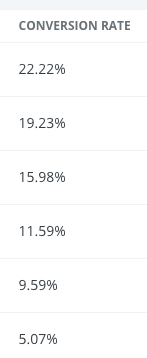
When they’re good, our CTAs are really good, and can convert in the 5-20% range.
But good CTAs don’t just fall out of our brains. Maybe you can relate.
The first versions of our CTAs are basically always bad, and then we go back and make them better. JFS principle #10, every version better.
But sometimes, the bad CTAs stick around for a lot longer than we intended. Sometimes…forever.
And if I’m totally honest, one of the reasons we often never got around to making our CTAs better (and sometimes, kept us from shipping the mediocre-to-terrible version) is because fiddling with HTML forms…sucks.
Now, given that Amy and I are both perfectly capable of coding HTML and CSS, this might be confusing to read, but hear me out!
Just because you can add some form code to a web page doesn’t mean it’s easy, or fast, to make it look nice and work as expected.
Adding a form to a page sounds like one step but there’s actually a bunch of steps and decisions along the way.
- You have write copy that will entice someone to sign up
- You have to style the CTA in a way that is eye-catching, but fits the theme of your website
- You have to make sure that styling works on both desktop and mobile layouts
- You have to set up a confirmation message or thank you page
- You have to handle anti-spam protection
- You have to handle GDPR and other compliance issues
- If you’re offering some sort of downloadable or series of emails, you have to create that and figure out the delivery
- Even if you’re not offering a downloadable or series, you probably want some kind of welcome email sent out automatically.
And really, that’s just the basics. Every single time you add an email form to your website.
Damn that’s a lot.
The thing is, Amy and I aren’t the types to spend lots of time fiddling with our opt-ins, either.
Actually that’s not true. We are those types, but we know better.
Instead, we choose to focus as much energy as possible prioritizing the things that directly serve our readers and our audience. We suck at so many things, but our success tracks directly with that priority,
So all of that friction of adding and maintaining our email opt-ins meant that, well, they kinda sucked!
We didn’t even have an opt-in on our home page until sometime in late 2019, almost 5 years after we launched the current website. 😬
With that in mind, you can understand why one of my absolute favorite features about ConvertKit is the ability to quickly add very nice looking, eye-catching, mobile-friendly, spammer-proof, and self-contained email opt-in forms to any web page with a single line of code. And with basic conversion analytics built right in!
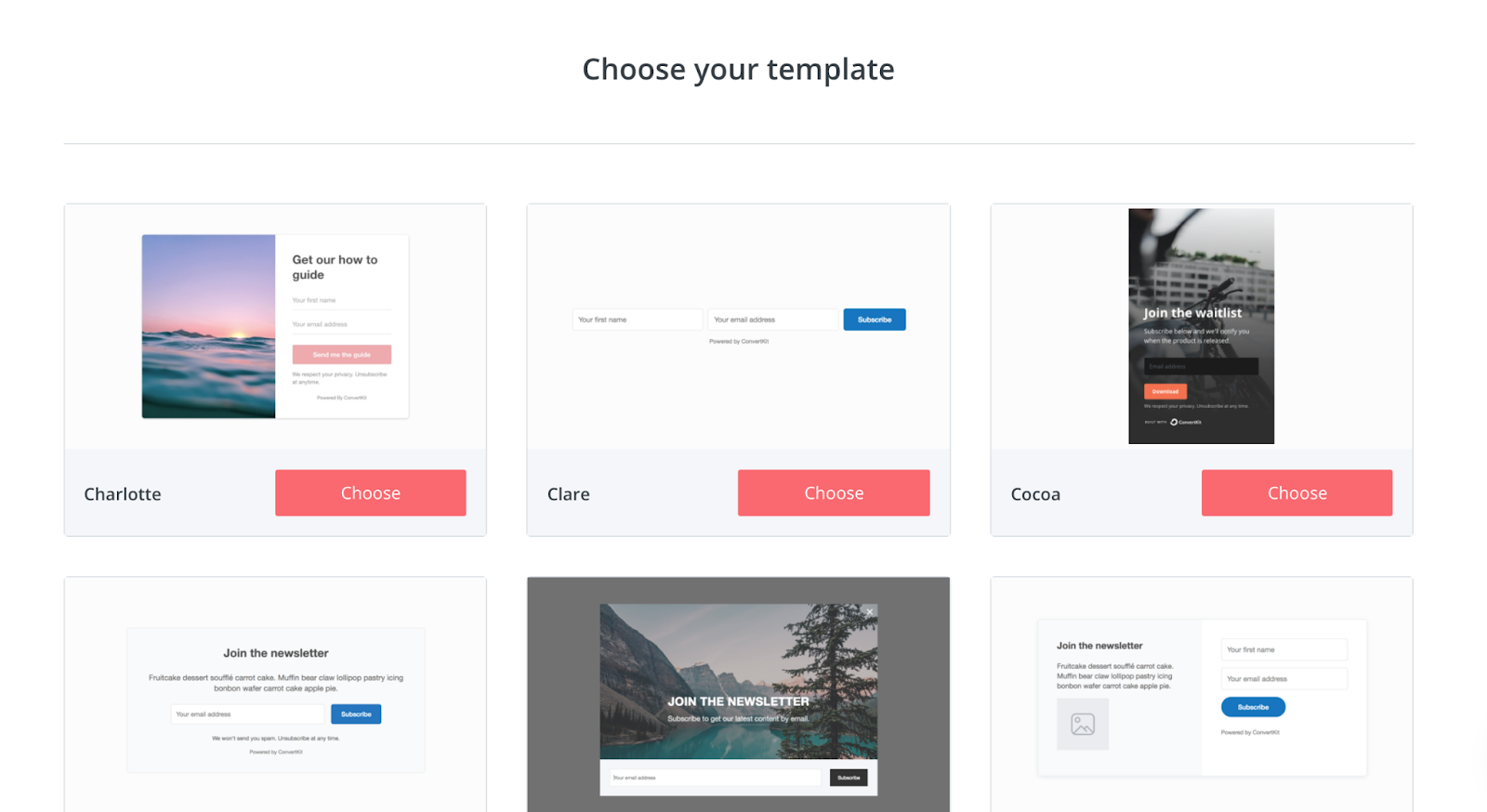

You can even make it so the same visitor won’t be shown a CTA they already signed up for (we do this on our homepage), or offer a paid offer in place of the email opt in on future visits.
They offer a lot of the same features in some schmancy email capture options too, like pop-ups and exit-intent windows.
But we keep it simple on Stacking the Bricks: inline CTAs with a clear reason to sign up.

I can create a custom CTA in less than 5 minutes with 4 of those minutes spent on button copywriting and none of it fiddling with HTML, custom confirmation pages, etc.
As a result, we’ve added more opt-ins to our website, and increasingly, more relevant opt-ins tailored specifically to the article or resources you’re reading.
This might seem like an overly obvious “win” to highlight, but I know that I’m not alone in having neglected, underperforming email opt-ins scattered across my website. So if that’s you, you’re not alone, and ConvertKit’s form embeds are one of the quickest ways to start tuning them up.
On our side this is still a work in progress (and probably will be forever!) but not because the forms are a pain in the butt. Success!
#2 - Relevant subscribers = more sales
When you ask someone for their email address, you’re asking for a kind of sale. Not with money, of course, but with permission and trust.
Hitting someone with an email opt-in before they’ve had a chance to read your page isn’t just annoying, it just doesn’t work.
“But I read that if you ask people right away you’ll get a higher conversion rate on that page!”
Those results will vary depending on your audience, but more importantly, remember what you’re optimizing for and it’s not simply “more emails.”
Try thinking about it this way:
Assuming the same value per customer, would you rather have 1000 subscribers that convert to customers at 1% or less, or 500 subscribers that convert to customers at 5% or better?
Clearly a smaller list that converts higher is more valuable, in this case 2.5x more valuable. When you EARN your readers’ email address, instead of badgering them (or worse, tricking them) to opt-in, what you’re really earning at that point is their trust.
And trust is a critical prerequisite for making sales.
So as you’re adding opt-ins to your site, instead of plastering them everywhere, put ‘em where it counts.
ConvertKit does let you choose a wide range of opt-in styles, including fancy pop-ups and exit intents (the opt-ins that automatically cover your screen when you move your cursor towards the back button).
We don’t use them.
Could we collect more emails if we did? Maybe! But we’d rather earn our email addresses.
And our very high list customer conversion rates and value per subscriber speak volumes to that approach. You DO NOT need a massive list to make lots of money.
So how do YOU use this knowledge?
When you’re working on improving your opt-in rates, start with your most valuable articles and landing pages.
Those would be the ones that get the most traffic, that get shared the most on social media, the ones that people write to you about and say “that thing you created so helpful, thank you!”
Make sure you have a ConvertKit email opt-in on that page. “Sign up to get my next post” is better than nothing, but leaves the reader unsure what that post is going to be about, if it’s going to be useful, or even when it might arrive.
Vague offers kill the desire to take action!
Instead, try offering something specific, related, and immediate.
You could offer a checklist or cheat sheet that helps them put the article into action. A workflow or a template that saves them time. A brief email course that guides them through the actions step by step. Something relatively small but useful to help them even more.
This opt-in offer is fine.
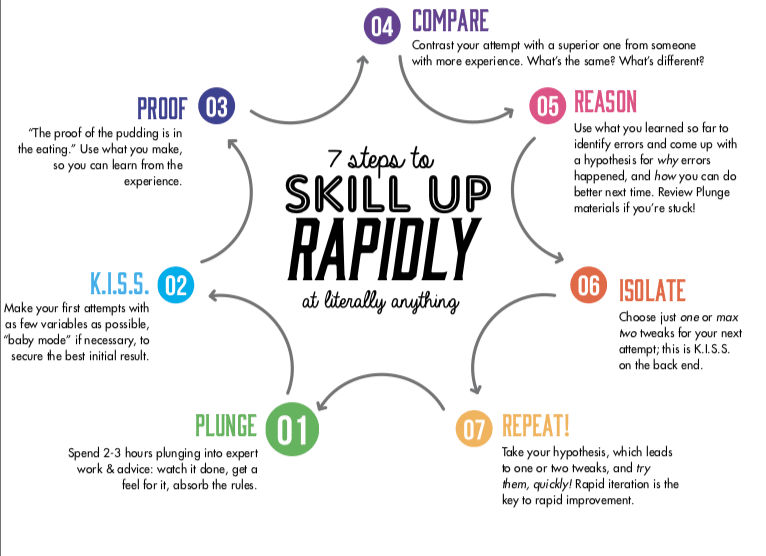
There's more where that came from
We email every Wednesday with the latest insights from our business, our students, and our research. Drop your email in the box below and we'll send new stuff straight to your inbox!
Absolutely no spam, ever. We respect your email privacy. Unsubscribe anytime. Huzzah!
It nets us plenty of subscribers. Notice how we’re still more specific than about the topics and timing!
👇 But THIS one works literally 2x better 👇
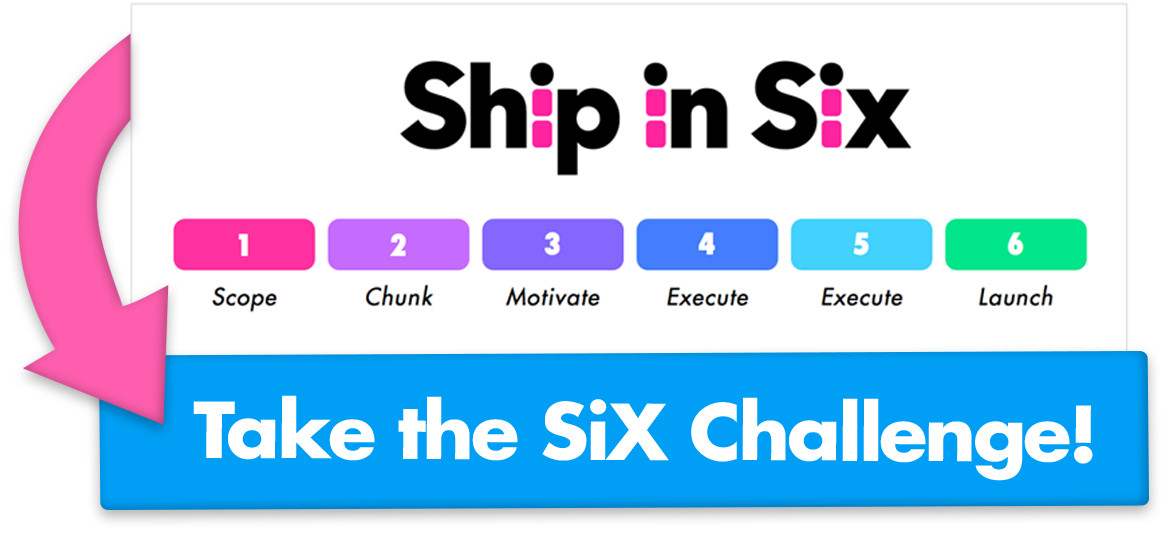
Scope, chunk, motivate, execute, and finally launch your project!
Join our challenge to get 6 weeks of rules and tricks from our personal playbook, along with personal stories and case studies to help you get that thing you've been wanting to finish, shipped.
When you subscribe, you’ll also get biz advice, design rants, and stories from the trenches once a week (or so). We respect your email privacy.
When you EARN their email, it’s step one to earning future sales.
So that “Get my next article sent directly to your inbox” at the end of an article they loved is better than nothing. And let’s be honest, you’ll find that kind of opt-in all over stackingthebricks.com
But email opt-ins convert MUCH higher when you can offer something specific, now, vs something theoretical, later. ConvertKit makes this easy - forms can be configured specifically to deliver a download, or to kick off a multi-email sequence.
Which brings me to my third and final way to succeed with ConvertKit…
Success #3: Getting off the content treadmill by making “mixtapes”
Most people (including us!) default to sending marketing emails the same way we send “normal” emails:
- We write the email, sharing a story or information or a link or something else.
- We press send. The end.
An email marketing tool lets you easily (and reliably) send that message to a lot of people, but after you’ve sent the email…then what?
Odds are, you spend a day or so obsessing over the open rates, and then you forget about it forever 😉
This is what I was referring to in the beginning of my email. That existential challenge of…the passing of time! 🔮
There is another way to send emails that multiplies your efforts: Sequence automation!
Marketing automation has become one of those things that everybody talks about, but very few people actually do well, so it gets a bad wrap.
Especially when it looks like this:
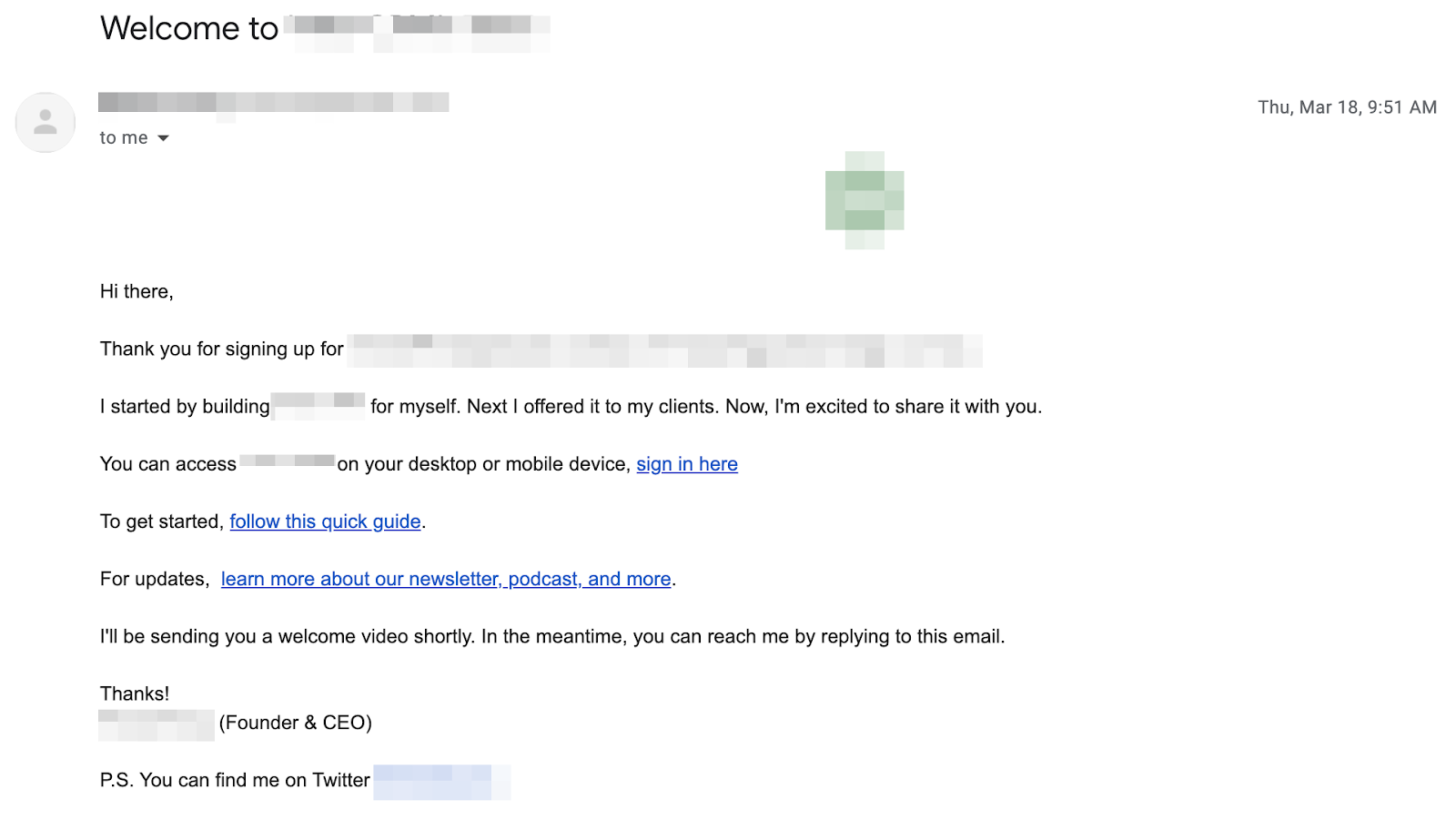
And with apologies to this well-meaning founder…this email is all about themselves and their product. None of it is about the reader.
Nobody thinks this email is real, or a truly personal email from the founder.
This kind of automation is the most common, and it sucks.
GOOD email automation serves the reader… and helps you bend time to your will!
Okay, maybe not exactly to your will but it sure does feel powerful once you get the hang of it.
Let’s try a quick thought experiment:
-
On Monday, you had 1000 subscribers.
-
You sent out your most recent essay to those 1000 subscribers.
-
On Tuesday, I joined your email list, excited to get new articles from you.
❓ When would I, a brand new subscriber, get the article you just sent less than 24 hours before?
Most likely answer is…never. That’s a bummer!
That’s a lot of time and effort to put into something that you only use once, isn’t it? No wonder writers get burnt out.
There is a better way…
You can’t avoid doing the work, but you CAN begin treating your work like an asset that works for you, and ConvertKit Sequences is one of the best ways to start in that direction.
If you’ve sent at least 7-10+ broadcasts to your list, you can level up your email game to get off the content treadmill and give your readers a better experience.
Best of all, you can turn it into a repeatable process that feels more like creating mixtapes (remember that!) than grinding out content.
And once you’ve learned the steps to create your own content mixtapes, it can feel a bit like magic bringing your old emails back to life….without the worries that come with traditional necromancy.
Part 2 of this guide includes the process, step by step, so drop your email in the box below and we’ll let you know when it’s live!
p.s. if you’ve gotten this far and still don’t have a ConvertKit account, consider using our referral link. We’d still share these tips without the kickback…these strategies have made us way more money than we’ll ever see from commissions, but a few extra bucks is nice!

